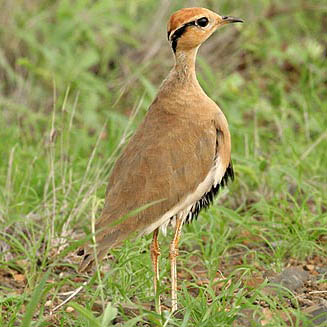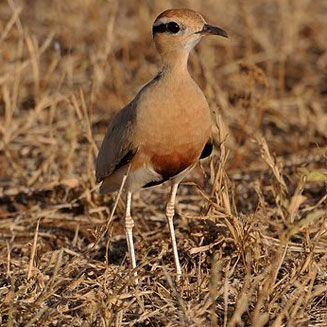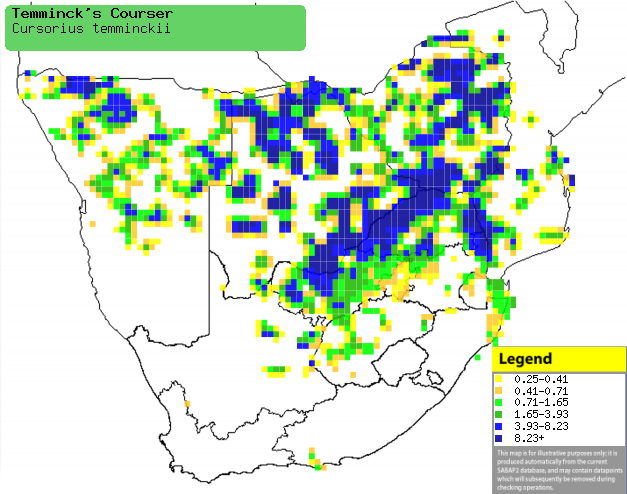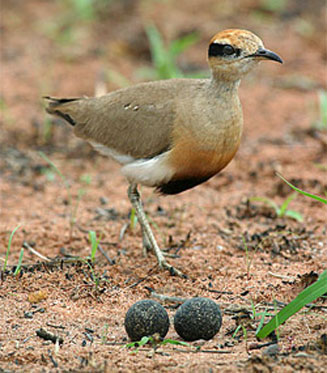|
Cursorius temminckii (Temminck's
courser)
Trekdrawwertjie [Afrikaans]; Ucelithafa [Xhosa];
uNobulongwe (generic term for courser) [Zulu]; Temmincks renvogel [Dutch];
Courvite de Temminck [French]; Temminckrennvogel [German]; Corredor de Temminck
[Portuguese]
Life
> Eukaryotes >
Opisthokonta
> Metazoa (animals) >
Bilateria >
Deuterostomia > Chordata >
Craniata > Vertebrata (vertebrates) > Gnathostomata (jawed
vertebrates) > Teleostomi (teleost fish) > Osteichthyes (bony fish) > Class:
Sarcopterygii (lobe-finned
fish) > Stegocephalia (terrestrial
vertebrates) > Tetrapoda
(four-legged vertebrates) > Reptiliomorpha > Amniota >
Reptilia (reptiles) >
Romeriida > Diapsida > Archosauromorpha > Archosauria >
Dinosauria
(dinosaurs) > Saurischia > Theropoda (bipedal predatory dinosaurs) >
Coelurosauria > Maniraptora > Aves
(birds) >
Order: Charadriiformes > Family: Glareolidae
 |
 |
|
Temminck's courser. [photo
Neil Gray
©] |
Temminck's courser, Kruger National Park, South
Africa. [photo
Callie de Wet ©] |
Distribution and habitat
Occupies much of sub-Saharan Africa, largely excluding the
lowland forest of northern DRC and West Africa. Within southern Africa it is common in
northern and central Namibia, Botswana, Zimbabwe, southern and central
Mozambique and north-eastern South Africa. It generally prefers clearings in miombo (Brachystegia) and Mopane (Colosphermum mopane)
woodland, as well as short and burnt grassland, dry or grassy pans, stubble
fields, fallow land, airfields, sports fields, overgrazed areas and cattle
kraals.
|
 |
|
Distribution of Temminck's courser in southern Africa,
based on statistical smoothing of the records from first SA Bird Atlas
Project (©
Animal Demography unit, University of
Cape Town; smoothing by Birgit Erni and Francesca Little). Colours range
from dark blue (most common) through to yellow (least common).
See here for the latest distribution
from the SABAP2. |
Predators and parasites
Movements and migrations
Its movements are exceedingly complex and not
fully understood, however it generally moves to arid areas (such as
in Botswana and Namibia) in the summer rainy season, while heading
to moist areas (including the Mashonaland plateau of Zimbabwe) in
the dry season, from June-December.
Food
It mainly eats insects, doing most of its foraging by
running and pausing repeatedly to pluck prey from the ground, often at the edge
of a bushfire. The following food items have been recorded
in its diet:
- Invertebrates
- insects
- Hodotermes mossambicus (Northern harvester termite)
- Coleoptera
(beetles)
- locusts and grasshoppers (Orthoptera)
- molluscs
- Seeds
Breeding
- Monogamous, solitary nester, performing courtship displays in which the
male and female bob up and down and left to right.
- It does not build a nest, instead laying its eggs on flat and bare
ground with good visibility, such as in the photo below.
 |
|
|
Temminck's courser at its nest with eggs, Sericea,
South Africa. [photo Warwick Tarboton ©] |
|
- Egg-laying season is mainly in the middle to end of the dry season, from
July-January.
- It lays 1-2 eggs, which are incubated by both sexes in shifts of about
75-120 minutes.
- The chicks are leave the nest within 7-8 hours of hatching, fed by both
parents until they still start self-feeding after eight days. They are able
to fly at 21 days old, fully fledging about a week later.
Threats
Not threatened, in fact widespread, common and
well-represented in protected areas, although it is sensitive to human
disturbance.
References
-
Hockey PAR, Dean WRJ and Ryan PG 2005. Roberts
- Birds of southern Africa, VIIth ed. The Trustees of the John Voelcker
Bird Book Fund, Cape Town.
|
